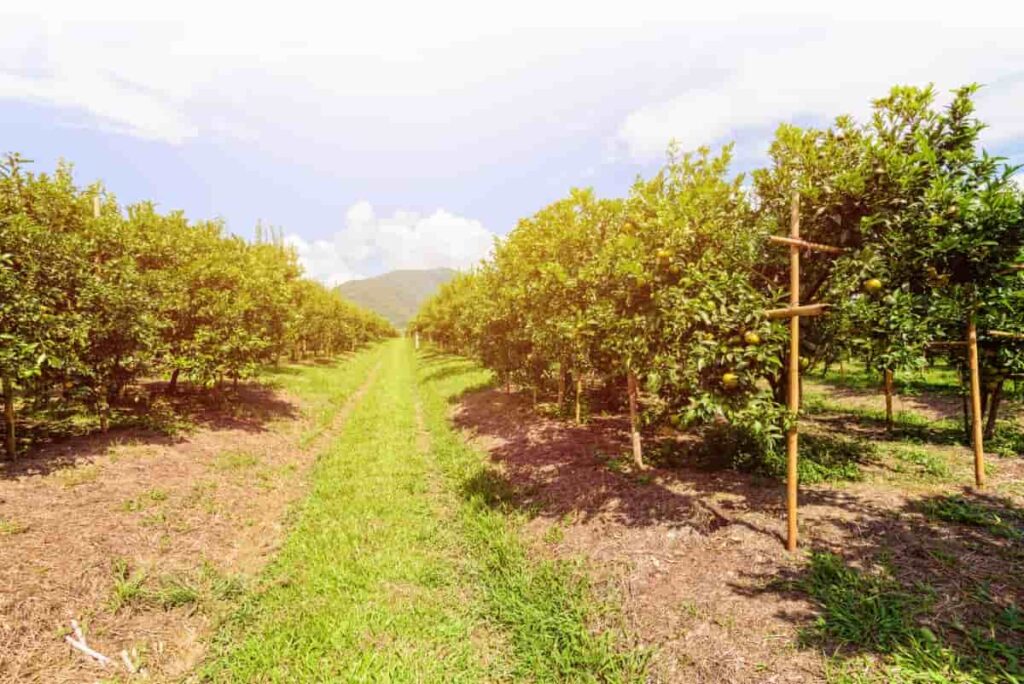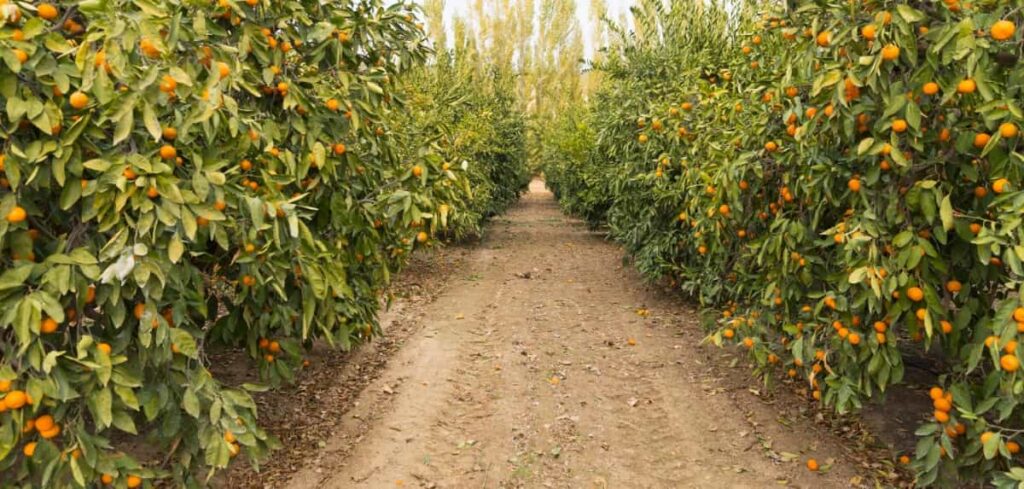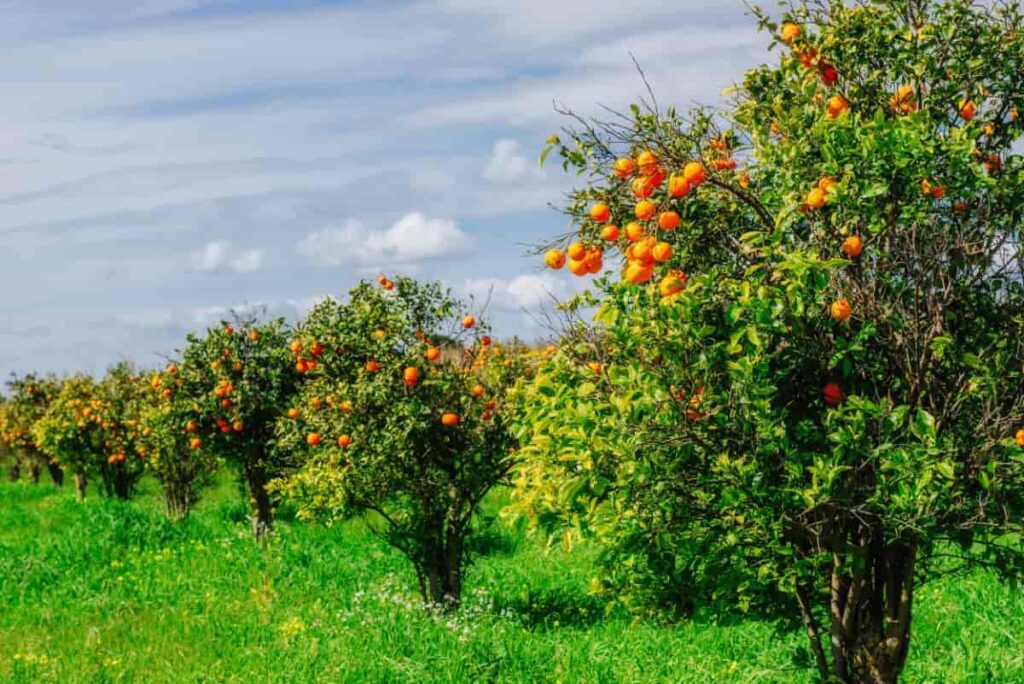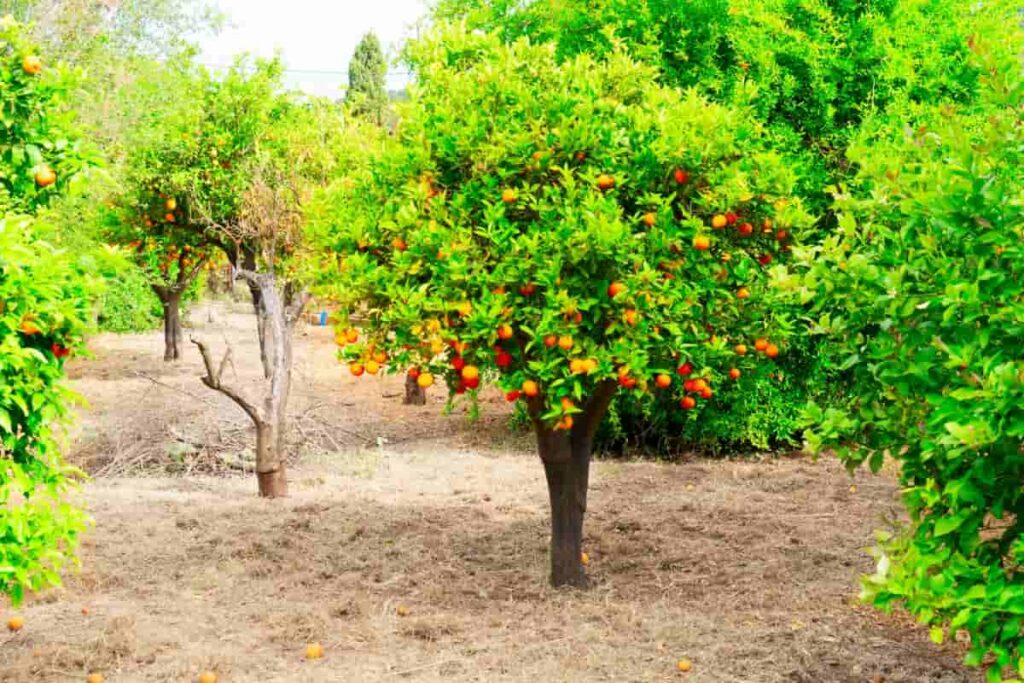Welcome to “Optimizing Sweet Orange Orchard Operations: A Comprehensive Guide for Every Month.” This guide is designed to simplify and streamline your sweet orange orchard management. Each month presents unique tasks for maximizing yield and quality. January focuses on pruning and thinning for robust growth. In February, we tackle fertilization and pest control. March emphasizes irrigation and weed management.

April demands blossom protection from frost. May is busy with fruit thinning and irrigation adjustments. June prioritizes fruit sizing and pest control. July calls for irrigation monitoring and foliar nutrient applications. August emphasizes canopy management and irrigation adjustments. September focuses on monitoring fruit maturity and quality.
October is the critical harvest month, with postharvest handling and storage in mind. November and December revolve around orchard maintenance and preparation for the upcoming season. This guide will optimize your sweet orange orchard, achieving high yields, superior quality, cost efficiency, and environmental sustainability.
Sweet Orange Orchard Management
What is Sweet Orange Farming and its Overview?
Sweet orange farming is an essential part of India’s agricultural landscape, with sweet oranges (Citrus sinensis) being the second-largest cultivated citrus fruit in the country. Major sweet orange growing states include Telangana, Andhra Pradesh, Maharashtra, Karnataka, Madhya Pradesh, and Punjab. Sweet oranges thrive in various soil and weather conditions, including tropical, subtropical, arid-irrigated, and mountainous regions.
While the sweet orange tree adapts well to dry climates, it performs best with rainfall between 750-1250 mm. Telangana, Andhra Pradesh, and Maharashtra have the highest cultivation share. In India, traditional sweet orange varieties like Mosambi (Maharashtra), Satgudi (Andhra Pradesh and Telangana), Malta, and Jaffa (Punjab) are commonly grown. However, the average yield of sweet oranges in India is lower (11.6 t/ha) compared to countries like the USA and Brazil (22-35 t/ha).
Importance of Month-Wise Planning for Sweet Orange Orchard Operations
- Month-wise planning maximizes productivity by taking timely actions for tree growth and fruit production.
- Optimal resource allocation saves costs and reduces environmental impact.
- Pest and disease management prevents outbreaks and ensures healthy trees and high-quality fruit.
- Weather considerations allow for irrigation adjustments and protection against frost.
- Monitoring fruit maturity and quality enables timely harvesting and market-ready produce.
- Orchard maintenance activities promote better tree health and airflow.
- Long-term sustainability is achieved through implementing sustainable practices.
- Adaptability and flexibility optimize operations based on unforeseen circumstances or new information.
In case you missed it: Orange Cultivation Information Guide

Best Package and Practices Operations in Sweet Orange
Soil
- Sweet orange grows well in differnt soils, including sandy loam, alluvial soils, clay loam, and lateritic/acidic soils.
- Well-drained with a pH range of soil 5.5 to 7.5 are ideal, but sweet oranges can tolerate pH levels from 4.0 to 9.0.
- Avoid soils with a high water table; prefer well-drained sandy loam to clay loam soils.
Climate
- Sweet orange thrives in tropical and subtropical climates and can withstand drought conditions.
- The average temperature for good growth ranges from 13ºC to 37ºC.
- It can be grown at altitudes between 500m to 1000m and in areas with rainfall up to 500mm.
Propagation
- Budding, specifically ‘T’ budding and patch budding or shield budding, are commonly used for propagating sweet orange.
- Rootstock plants are budded about 15-25 cm from the ground level.
Planting
- Planting is typically done from June to March.
- Pits with dimensions of 2x2x2 feet in deeper soils or 3x3x3 feet in shallow soils are prepared.
- The pits are filled with topsoil, organic matter, fertilizers, and pest control agents.
- Watering immediately after planting is essential.
Intercrop
- Intercropping is not recommended immediately after planting, but seasonal crops can be grown below the tree’s height from the second year onward.
- Seasonal crops such as black gram, mung, groundnut, and soybean can be chosen.
Mulching
Use wheat husk, dry leaves, and sugarcane to protect the orchard from weeds and the scorching sun. The husk should be used in an 8 cm thick layer on raised beds. It also helps to reduce evaporation rates and improve fruit quality.
Micronutrients
Applying specific micronutrients in the soil is recommended for the best growth and health of citrus plants. Copper sulfate, ferrous sulfate, and zinc sulfate are commonly used micronutrients for citrus plants.
Harvesting
Sweet oranges should be harvested with the proper size, attractive color, and a desirable sugar-to-acid ratio when fully ripe. Since sweet oranges are non-climacteric fruits, their color, taste, and flavor do not improve after harvesting. However, they can remain on the trees for several weeks without deterioration, except in areas where fruit-sucking moths or granulation are issues. In those cases, early picking is recommended. The main harvesting season for sweet oranges in North India is from December to February, while in South India, it is from October to March.
In case you missed it: Optimizing Coconut Orchard Operations: A Comprehensive Management Guide for Month-wise Planning

Post-Harvesting
Sweet oranges, known for their tight skin and longer shelf life than mandarins, undergo a terminal ripening period where they develop a complete blend of flavor, texture, and aroma. The optimal harvesting time for different sweet orange varieties is based on the desired TSS (Total Soluble Solids) to acid ratio and rind color.
Postharvest handling involves washing, drying, sorting, grading, and wrapping in tissue paper. Dipping fruits in fungicidal emulsion and treating them with Benlate or Carbendazin solution is recommended to reduce spoilage. Storage at specific temperatures and humidity levels can extend the shelf life of different varieties, such as Malta, Satgudi, and Mosambi.
Yield
- Bearing starts from the 3rd year.
- The expected commercial yield begins in the 4th year at 5-6 tons/acre.
- From the 5th year onwards, yield ranges from 8-12 tons/acre.
January Month Sweet Orange Orchard Operations Planning
- Pinch off any appearing flowers on grafted plants.
- Control Powdery Mildew and leaf hoppers by spraying Wettable Sulphur (80% WP) at 3 grams per liter of water, combined with phosphomidon at 2 milliliters per liter of water if the issue is not controlled.
February Month Sweet Orange Orchard Operations Planning
- Regularly irrigate the plants every five days.
- Monitor for bark borer and stem borer infestations, likely during hot weather.
- Control them by injecting 10 ml of Dichlorovas per liter of water into the damaged holes and sealing them with sticky soil.
- Apply Bordeaux Paste on the trunk up to 30 to 45 cm height to prevent termite infestations and fungal diseases.
March Month Sweet Orange Orchard Operations Planning
- Fertilizers: As the 3rd top dressing, apply the following amounts per plant:
- Urea: 50 gm
- Single Super Phosphate: 125 gm
- Murate of Potash:f 40 gm
- Control evapotranspiration losses and weed growth in the basins by applying one basket full of mulch material.
In case you missed it: Optimizing Apple Orchard Operations: A Comprehensive Guide for Month-wise Planning

April Month Sweet Orange Orchard Operations Planning
- Soil suitability: Conduct a soil analysis by digging a 3x3x3 ft profile pit. Avoid soils with calcareous nodules or sheetrock. Also, avoid waterlogged, poorly drained soils and black cotton soils.
- Soil sampling: Collect soil samples from each foot of depth in the suitable areas identified during the profile pit analysis.
- Soil pH: Check the soil pH using the soil test report. Soil pH ranging from 7.0 to 8.0 is suitable for sweet orange plantation. Avoid soils with pH below 6.0 or above 8.5.
- Electrical Conductivity (EC) and Exchangeable Sodium: Avoid soils and irrigation water with an EC above 1.0 dS/m (decisiemens per meter) and exchangeable sodium above 15%.
- Irrigation: Ensure regular irrigation for sweet orange trees. Drip irrigation is preferred, but if not available, provide basin irrigation at least once every five days.
May Month Sweet Orange Orchard Operations Planning
- Summer plowing: Conduct two rounds of plowing using an MB (Mouldboard) plow to prepare the land. Ensure proper leveling of the land.
- Irrigation: Implement regular irrigation practices through drip irrigation or basins irrigation. Provide water at least once every five days.
- Soil working: Perform soil working to create a soil mulch, which helps conserve moisture and reduce weed growth.
- Alignment and peg marking: Mark the alignment and spacing for pit digging. Maintain a distance of 6.0 meters between rows, and ensure appropriate spacing for planting the orange trees.
- Pit digging: Take precautions while digging the pits. Place the top soil (1 ½ ft.) on the right side of the pit and the bottom soil (1 ½ ft.) on the left side. Allow the pits to be exposed to sunlight for at least two weeks before filling them. This helps in controlling soil-borne pests and diseases.
- Procurement of plant material: Make necessary arrangements for procuring plant material from reliable nurseries. Obtaining the plants from government nurseries or nurseries recommended by the Department of Horticulture is preferable.
June Month Sweet Orange Orchard Operations Planning
In June, sweet orange orchard operations planning includes various tasks. Firstly, pit filling is done by filling the pits with topsoil mixed with 50 kgs of Farm Yard Manure (FYM), 1 kg of Single Super Phosphate, 1 kg of Neem Cake, and 100 gm of 10% Follidol dust per pit. The pits should be filled at least 6 inches above the ground level to compensate for settling.
In case you missed it: Optimizing Mango Orchard Operations: A Comprehensive Guide for Month-wise Planning

Thorn fencing or a thick live fence is recommended to prevent cattle trespassing. Trench cutting for drip installation should be marked out and completed. With the arrival of the monsoon, farmers can sow intercrops. As for fertilizers, the 3rd top dressing for each pit should consist of 50 gm of Urea, 125 gm of Single Super Phosphate, and 40 gm of Murate of Potash.
July Month Sweet Orange Orchard Operations Planning
- Farmers should procure plant material from selected nurseries, ensuring high-quality plants to avoid future losses.
- The graft should have 4 to 6 flushes with a 60 to 75 cm height.
- The graft union should be perfect and at least 6” above the soil in the poly bag.
- The graft should be free from side shoots on the rootstock, and the sapling should be healthy and pest/disease-free.
- Arrange transportation of the saplings from the nursery to the planting site.
- Keep the saplings near a water source and water them regularly until planting.
- If there is a delay in receiving good rains, soak the pits with irrigation or the drip system, ensuring the soil level is at ground level.
- Plant the saplings in the pits without disturbing the earth around the root system, ensuring the graft union is 6” above ground level.
- Stake the plants with strong support sticks, dipping the bottom to stick in black tar to prevent termite attacks.
- Water the plants immediately after planting.
- Irrigate the plants every 4 to 5 days during the first month and later at 8 to 10 days intervals if there is no rainfall during the initial two years.
August Month Sweet Orange Orchard Operations Planning
- New growth on planted saplings will begin in approximately 2 to 3 weeks. To protect the new development from leaf-eating caterpillars or beetles, it is recommended to spray Quinolphos or Endosulphon at a rate of 2 ml per liter of water. This spraying should be done at intervals of 15 to 20 days.
- Weeding carried out at least once a month during the monsoon season to control weed growth. Additionally, it is important to create basins around the plants to retain water effectively.
- To minimize evapo-transpiration losses and control weed growth in the basins, it is advisable to mulch them with materials such as paddy husk, paddy straw, or groundnut shells.
- Remove any side shoots that appear on the rootstock to ensure the healthy growth of the main plant.
- Leaf spot diseases can occur during heavy rains in August and September. It is crucial to control these diseases by spraying Copper Oxy Chloride (Blitox) at 3 grams per liter of water. Failing to prevent these diseases in a timely manner may result in twig drying (Dieback), eventually leading to the death of the plants.
September Month Sweet Orange Orchard Operations Planning
- Termite control: Check for termite attacks on support sticks. To address this issue, spray Chloropyriphos (Termex-C) at a rate of 5 ml per liter of water on the stem and support stick. Additionally, drench the basins with the same chemical.
- Micronutrient deficiencies: If any micronutrient deficiencies are observed, spray Multiplex at a rate of 5 gm per liter of water. This mixture can be combined with any pesticide and sprayed.
- Leaf galls: If leaf galls are noticed on new flushes, remove the affected leaves and spray Phosphomidon at a rate of 1.5 ml per liter of water.
- Fertilizer application: As the first top dressing for each pit, apply the following fertilizers:
- Urea: 50 gm per plant
- Single Super Phosphate: 125 gm
- Murate of Potash: 40 gm
Ensure the fertilizers are applied at least 6 inches from the plant. After applying the fertilizers, irrigate the pits immediately.

October Month Sweet Orange Orchard Operations Planning
- Gap filling: If plants have died, they should be replaced by filling the gaps.
- Removal of side shoots: Eliminate any side shoots that appear on the rootstock.
- Planting in high rainfall zones: Optimal time for planting in areas with high rainfall is from October to November.
- Inter-cropping: If inter-cropping was not cultivated during June-July, farmers could sow intercrops for the rabi season in October.
November Month Sweet Orange Orchard Operations Planning
In November, focusing on soil working in the basins and implementing mulching techniques in sweet orange orchards is crucial. Additionally, removing any side shoots that may emerge on the rootstock is important. These tasks are essential for maintaining the health and productivity of the orchard during this month.
December Month Sweet Orange Orchard Operations Planning
- Pinching: Remove flower buds as soon as they appear on grafted plants to promote better growth. Otherwise, the flowers can hinder the overall development of the plants.
- Disease and pest control: Cool and foggy weather during this month can attract Powdery Mildew diseases and leaf hoppers. To combat them, spray Wettable Sulphur (80% WP) at a rate of 3 gm per liter of water and phosphomidon at 2 ml per liter of water.
- Fertilizer application: As the second top dressing, apply the following fertilizers per pit:
- Urea: 50 gm
- Single Super Phosphate: 125 gm
- Murate of Potash: 40 gm
Make sure to use the fertilizers at least 6 inches from the plant. After application, rinse the pits immediately.
Conclusion
To optimize sweet orange orchard operations, it is essential to follow a comprehensive guide. Each month, from pruning and fertilizing to pest control and irrigation, requires specific actions. By implementing these practices, growers can enhance productivity and maintain the health of their orchards year-round.
- Profitable Village Farming Business Ideas in 2024
- High-Yield Aquaculture: Fast-Growing Fish for Farming
- Effective Fish Pond Construction Techniques for Beginners
- Irrigation and Water Management in Pineapple Farming
- Blossom to Harvest: Mastering Flowering and Pollination in Papaya Farming
- Pig Fattening Essentials: From Selection to Sale for Beginners
- Raising Wagyu Cattle: A Complete Guide for Premium Beef Production
- Soil Types and Their Water Holding Capacity
- Optimizing Irrigation Schedules for Coconut Groves for Enhanced Yield
- Espresso Your Garden: Coffee Grounds for Healthier Acid-Loving Plants
- The Best Soil Mix for Snake Plants: How to Mix Your Own Snake Plant Soil
- Green Thumb Success: Expert Tips for Cultivating Greenhouse Beans All Year Round
- Bloom All Year Round: The Ultimate Guide to Indoor Hyacinth Care
- Eco-Friendly Gardening: How to Make Liquid Fertilizer from Kitchen Waste
- Ultimate Guide to Grow Anise in Pots: Explore Seed Propagation to Harvesting
- Guide to Raising Chester White Pigs: Discover Breed Facts to Growth Management
- Mastering the Elegance: The Ultimate Guide to Weeping Cherry Tree Care, Planting, and Maintenance
- Ultimate Guide to Planting Garlic in Grow Bags: Growing Strategies for Beginners
- How to Fix Spider Plant Leaf-Related Problems: Natural and Organic Remedies
- 10 Reasons Why Your Tulsi Plant is Shedding Leaves: Home Remedies and Solutions
- Optimizing Growth and Yield: The Advantages of Palm Bunch Ash Fertilizer
- Utilizing Neem Oil Extract as a Natural Pesticide for Hydrangea
- From Soil to Harvest: Various Ways in Which Farmers Can Use AI Tools
- Steps to Encourage and Induce Citrus Flowers: A Comprehensive Guide
- How to Fix Snake Plant Leaf-Related Issues: Natural and Organic Remedies
- Transform Your Garden into a Fragrant Oasis with Raat Ki Rani (Night Blooming Jasmine)
- Discover the Ideal Chicken Breeds for Philippine Farms
- How to Create a Poultry Egg Farm Business Plan for Profits
- Grow Lemon Cucumbers Like a Pro: Insider Techniques for Bountiful Yields
- Ultimate Guide to Caring for Your Pink Princess Philodendron: Tips for Thriving Variegation
- Areca Nut Profit Per Acre: Calculating Yield and Cost of Cultivation
- How Kaveri Chicken is Becoming a More Profitable Breed in Indian Backyards
- Transform Your Barn: 9 Steps to Convert a Horse Stall into a Chicken Coop
- Exploring Suffolk Sheep Disadvantages with Limitations and Challenges
- Guide to Solving Potted Lemon Tree Problems: How to Revive Lemon Tree in Containers
- Steps to Encourage Female Pumpkin Flowers: Best Strategies for More Flowers and High Yields
